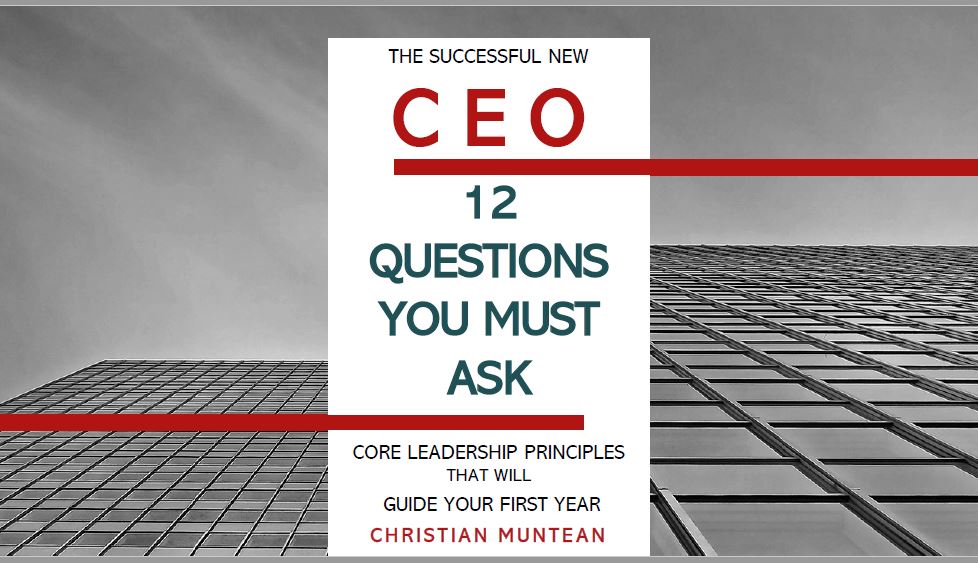I heard that what gets measured gets managed. What should I measure?

 I opened the door to walk our dog. Overnight our neighborhood had undergone a transformation. A white blanket had settled. Just like that: Fall had become winter.
I opened the door to walk our dog. Overnight our neighborhood had undergone a transformation. A white blanket had settled. Just like that: Fall had become winter.
Nala the rescue pooch and I take our walks very early in the morning. Almost no one is awake. It’s quiet and still.
We were making the first tracks in the snow. Looking back, you could clearly see that they originated from our front door.
It was interesting to me. Just the day before, it would have been impossible to tell that anyone had passed by. Now it was evident to anyone where we had come from and, soon, where we were going.
As we walked, we saw other tracks. A neighbor had, apparently, driven somewhere in the middle of the night. There had been enough snow to leave tire tracks but they were partially covered.
Further on, a rabbit had hopped across the street. A moose had wandered through a yard.
It’s all normal activity in our neighborhood. But before the snow, unless you caught something in action – you may never have known it had passed by.
Later in the day, activity increased. The snow is still there, but there are so many tracks, it’s difficult to read them. It’s hard to know where they came from and where they are going.
Tracks In Your Business
All businesses have activity. But for many, any activity besides the most obvious is difficult to see. Frequently leaders depend on limited cues or close monitoring to track what is happening. Many rely heavily on someone’s “gut” feeling.
The only upside to this approach is that it takes no extra effort or knowledge to set up. The downside is that as activity increases, it becomes more and more difficult to ascertain what is going on.
As a result, leaders find themselves subconsciously limiting growth. It’s not that they don’t want to grow. But they don’t like how growth makes the business feel out of control.
Alternatively, some businesses do gather information. They know they need to track it. But it is so voluminous and complex that it becomes unreadable and overwhelming.
They don’t know what they need to know. The important tracks are lost.
But what a wonderful world it is once you can see what is happening in your business – and you know how to track only the information that you need. In this world, amazing opportunities open up. Challenges are easily prepared for or avoided altogether.
What Tracks Do You Need To See?
This is where the complexity first emerges – what do we need to know? The answer depends on the kind of business you are in, your environment, and your goals. So, what one company may need to track may not apply to another.
Here’s how to think through this:
Begin by tracking progress toward your Values, Vision, and Goals.
Healthy businesses actively create alignment between their high-level values, their vision for the future, and the goals they are pursuing right now. This is a combination of culture and goals.
You should be able to answer these questions:
- Values: How do we know our values are consistently demonstrated throughout our organization? What typical, observable behaviors reflect these values? What typical outcomes are the result of living into these values?
- Vision & Goals: How will we know we’ve accomplished our vision or our goals? What will indicate progress towards either?
In case you believe this is too fluffy bunny and esoteric: My clients who become good at doing the above discover that they also become better at attracting and retaining ideal employees, improving their profits, and lowering costs.
Businesses that ignore the above and first chase employees, profit, or reducing costs find that their efforts produce a limited return – and are often unsustainable.
Basic Categories You Should Track:
You can’t operate for long without three basic areas of your business working to some degree. If they all work well, you have the ingredients for a successful company. These are:
- Financial performance
- Customer satisfaction
- Employee satisfaction
But you have to be able to measure or track each of these. Your intuition, or “gut”, may be good. But it can only go so far.
Below I’ll include a list of recommended areas to track within each of these three categories. You don’t need to use all of them. And your specific needs may be different. But each general category should be tracked in some way.
Financial Performance
- Cash flows: Tracking and predicting in and outflow of cash.
- Profitability: Tracking the gain or return from business activities and resources.
- Accounts Payable: Tracking what needs to be paid, when, to whom, and with what terms.
- Accounts Receivable: Tracking what is owed, by whom, for what, and for how long.
There are many more financial metrics that can be used. But the above four are good starting points for many businesses. Even large “sophisticated” businesses are often not as clear as they should be on the above.
Customer Satisfaction
- Acquisition: Who is your ideal customer? How are your customers acquired? How many of them are your ideal? What is the cost of acquisition in terms of time, effort, or financial costs?
- Retention: How long do your customers tend to stay with you? What tends to cause them to leave or not return?
- Satisfaction: How pleased are your customers? What are you doing or offering that they respond to the best? What do they like the least?
Mature, healthy businesses understand their customers. They seek to build a positive relationship with them.
Employee Satisfaction
- Satisfaction: How happy and content are your employees?
- Retention & Tenure: What is a reasonable length of tenure for any specific position? Are you retaining people for at least that long? Are you “graduating” people from one level of skill or responsibility to another? What does it cost to train and onboard someone? When have you at least “broken even” with an employee?
- Growth: How do employees grow within your company? How is growth tracked or encouraged? How are their skills or the results they produce tracked or coached?
How To Interpret Results?
Your first goal should be your industry’s norms. Sometimes you can find these online. Or your professional association may have conducted a relevant study.
But in my experience, most organizations are not operating optimally. So, once you are meeting basic norms – start to identify an area or two to become exceptional in. This will help make you a leader within your industry.
What I’m describing above is a very simple and highly effective way to manage with metrics.
How to begin?
Keep it simple. Keep it useful.
Perhaps begin with even just one or two metrics to track in each category. Only track what you need to know.
Begin with metrics that are easy to track. As you become comfortable with them, move into the ones that are valuable but may require a little more effort or a new process.
Don’t overwhelm yourself.
And don’t forget that everything should stay aligned to your values, vision and ultimate goals.
Good metrics should be like clear tracks in the snow – they tell you where you’ve been and give a good indication of where you are going.
Take good care,
Christian
P.S. Here’s how to get free money!* I say that at risk of discrediting everything I say after.
But every now and then, something that sounds too good to be true – actually is true. I’m referring to the Employee Retention Credit (ERC). My clients who have pursued this have come back with a minimum of six figures in tax credits.
Here’s an article on Forbes that describes it.
The short version of the story is: To help save us from COVID, the US Government created a temporary tax credit for everyone who kept their employees during the period of the shutdowns.
They initially made it so complicated and confusing that essentially no one pursued it (this might be why your accountant hasn’t mentioned it). They fixed that and now it is ridiculously easy to qualify for.
Better late than never.
To find out if you qualify, follow this link. You can get a lot of your questions answered without having to talk to anyone.
Feel free to ask your accountant about it too.
*I have absolutely no business interest in this. I just thought you should know.
Free Leadership Resources
Whether you are a new CEO, thinking of succession or exit, or wanting to strengthen your leadership and your team, I’ve got resources to help:
Enhancing your leadership skills
Are you interested in learning more about becoming a successful CEO? If so, get a free copy of my book The Successful New CEO. Not a new CEO? I’ve been told by “old hands” that they felt any CEO should read this. So, click here to get your copy today.
by “old hands” that they felt any CEO should read this. So, click here to get your copy today.
There are 𝟭𝟮 𝗰𝗿𝗶𝘁𝗶𝗰𝗮𝗹 𝗾𝘂𝗲𝘀𝘁𝗶𝗼𝗻𝘀 to ask before accepting a new CEO position. Do you know what they are? Instantly download my free e-book here.
𝗧𝗵𝗲 𝗕𝗲𝘀𝘁 𝗧𝗶𝗺𝗲 𝘁𝗼 𝗖𝗿𝗲𝗮𝘁𝗲 𝗔𝗻 𝗘𝗺𝗲𝗿𝗴𝗲𝗻𝗰𝘆 𝗦𝘂𝗰𝗰𝗲𝘀𝘀𝗶𝗼𝗻 𝗣𝗹𝗮𝗻 𝗶𝘀 𝘽𝙚𝙛𝙤𝙧𝙚 𝗬𝗼𝘂 𝗡𝗲𝗲𝗱 𝗜𝘁.
Be prepared for a smooth transition in the event of an unplanned emergency succession. My guide will show you step-by-step how to devise your own plan.
Let’s connect.
I’m passionate about helping leaders to create workplaces they love going to and increasing the value of the services they offer. My results-oriented approach is tailored to each client’s specific situation and needs. As a leadership coach, I have developed a wealth of resources to help you and your team grow and become stronger.
Weekly Newsletter – sign up to receive my weekly articles addressing critical leadership challenges and issues.
The Leadership Coach Podcast – In my podcast, we explore effective, high-impact, and enjoyable leadership. Subscribe.
Find the value of your company with my free assessment tool: The Value Builder System
The Value Builder System™ is a 13-minute online questionnaire that evaluates your business on the eight factors that contribute more to its attractiveness and value. These factors are scored on a scale of 1-100. Businesses that score over 80 are likely to command 70%-100% higher value than others.
Opportunities
Executive and Leadership Coaching: Do you feel overwhelmed? Are you not getting the results you expect from the effort you are putting in? Do you find yourself facing similar challenges time and time again? Would you like to change specific ways of relating or reacting? If you would like to experience predictable, measurable growth Contact me.
Profitable Exit Strategy Workshop: Are you a business owner or partner? Over 55? Starting to think about exiting your business or active management in the next 3-5 years?
- Curious about what your business might be worth?
- Would you like to discover the specific steps you need to take to increase its value and become highly attractive to a buyer?
- Are you planning on handing it over to family or employees and you want to ensure long-term success?
If so, contact me now
Categories
Get Christian’s Newest Book: Train to Lead

Download my free 10-page eBook:
How To Accomplish More Without Doing More:
Eight Proven Strategies To Change Your Life
Discover how to save eight hours during your workweek-even if you're too busy to even think about it. The resource every maxed out executive needs.

